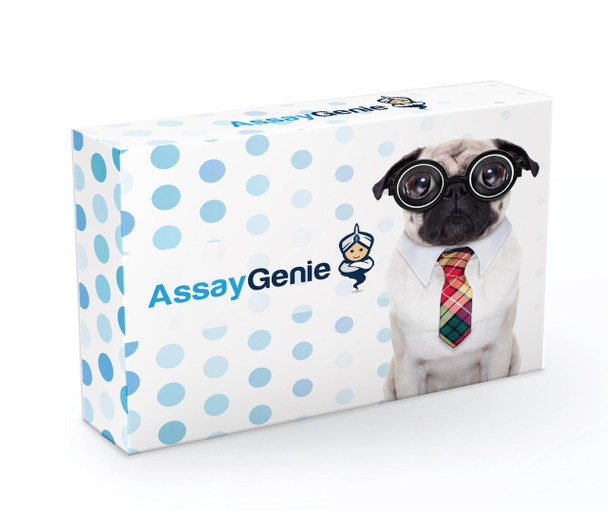Description
| Product Name: | GSH (Reduced Glutathione) colorimetric Assay Kit |
| SKU: | AEFI01416 |
| Size: | 96T |
| Reactivity: | Universal |
| Range: | 1.56-100umol/L |
| Sensitivity: | 1.2umol/L |
| Detection Method: | Colorimetric Assay |
| Detection Wavelength: | OD405 |
| Reaction Duration: | 20 minutes |
| Synonyms: | GSH ELISA Kit, Reduced Glutathione ELISA Kit |
| Recovery: | Add a certain amount of GSH into the sample. Calculate the recovery by comparing the measured value with the expected amount of GSH in the sample.
| ||||||||||||||||||||||||||||||||||||||||||
| Linearity: | Dilute the sample with a certain amount of GSH at 1:2, 1:4 and 1:8 to get the recovery range.
| ||||||||||||||||||||||||||||||||||||||||||
| Precision: | Intra-assay Precision: samples with low, medium and high concentration are tested 20 times on the same plate. Inter-assay Precision: samples with low, medium and high concentration are tested 20 times on three different plates.
| ||||||||||||||||||||||||||||||||||||||||||
When carrying out an ELISA assay it is important to prepare your samples in order to achieve the best possible results. Below we have a list of procedures for the preparation of samples for different sample types.
| Sample Type | Protocol |
| Serum | Place whole blood sample at room temperature for 2 hours or at 2-8°C overnight. Centrifuge for 20min at 1000xg and collect the supernatant to detect immediately. Or you can aliquot the supernatant and store it at -20°C or -80°C for future’s assay.. |
| Plasma | EDTA-Na2/K2 is recommended as the anticoagulant. Centrifuge samples for 15 minutes at 1000×g 2-8°C within 30 minutes after collection. Collect the supernatant to detect immediately. Or you can aliquot the supernatant and store it at -20°C or -80°C for future’s assay. For other anticoagulant types and uses, please refer to the sample preparation guideline.. |
| Tissue Sample | Tissue samples are required to be made into homogenization. Protocol is as below: 3.1. Place the target tissue on the ice. Remove residual blood by washing tissue with pre-cooling PBS buffer (0.01M, pH=7.4). Then weigh for usage. 3.2. Use lysate to grind tissue homogenates on the ice. The adding volume of lysate depends on the weight of the tissue. Usually, 9mL PBS would be appropriate to 1 gram tissue pieces. 3.3. Do further process using ultrasonic disruption or freeze-thaw cycles (Ice bath for cooling is required during ultrasonic disruption; Freeze-thaw cycles can be repeated twice.) to get the homogenates. 3.4. Homogenates are then centrifuged for 5 minutes at 5000×g. Collect the supernatant to detect immediately. Or you can aliquot the supernatant and store it at -20°C or -80°C for future’s assay. 3.5. Determine total protein concentration by BCA kit for further data analysis. Usually, total protein concentration for assay should be within 1-3mg/ml. Notes:PBS buffer or the RIPA lysis can be used as lysates Avoid using any reagents containing DTT Or reducing agent due to their severe interfere with kits’ working. |
| Cell Culture Supernatant | Collect the supernatant: Centrifuge at 2500 rpm at 2-8℃ for 5 minutes, then collect clarified cell culture supernatant to detect immediately. Or you can aliquot the supernatant and store it at -80°C for future’s assay.. |
| Cell Lysate | 5.1. Suspension Cell Lysate: Centrifuge at 2500 rpm at 2-8℃ for 5 minutes and collect cells. Then add pre- cooling PBS into collected cell and mix gently. Recollect cell by repeating centrifugation. Add 0.5-1ml cell lysate. Lyse the cell on ice for 30min-1h or disrupt the cell by ultrasonic disruption. 5.2. Adherent Cell Lysate: Absorb supernatant and add pre-cooling PBS to wash three times. Add 0.5-1ml cell lysate. Scrape the adherent cell with cell scraper. Lyse the cell suspension added in the centrifuge tube on ice for 30min-1h or disrupt the cell by ultrasonic disruption. 5.3. During lysate process, use the tip for pipetting or intermittently shake the centrifugal tube to completely lyse the protein. Mucilaginous product is DNA which can be disrupted by ultrasonic cell disruptor on ice. (3~5mm probe, 150-300W, 3~5 s/time, 30s intervals for 1~2s working). 5.4. At the end of lysate or ultrasonic disruption, centrifuge at 10000rpm at 2-8℃ for 10 minutes. Then, the supernatant is added into EP tube to detect immediately. Or you can aliquot the supernatant and store it at - 80°C for future’s assay. Notes:Read notes in tissue sample. |
| Other Biological Sample | Centrifuge samples for 15 minutes at 1000×g at 2-8℃. Collect the supernatant to detect immediately. Or you can aliquot the supernatant and store it at -80°C for future’s assay. |
| UniProt ID: | CAS: 70-18-8 |
| Sample Type: | Serum, Plasma, Cell culture supernatant, Cell or tissue lysate, Other liquid samples |
| Storage: | 2-8°C(Sealed), Don't cryopreserve. |
| Specificity: | Specifically binds with GSH , no obvious cross reaction with other analogues. |






